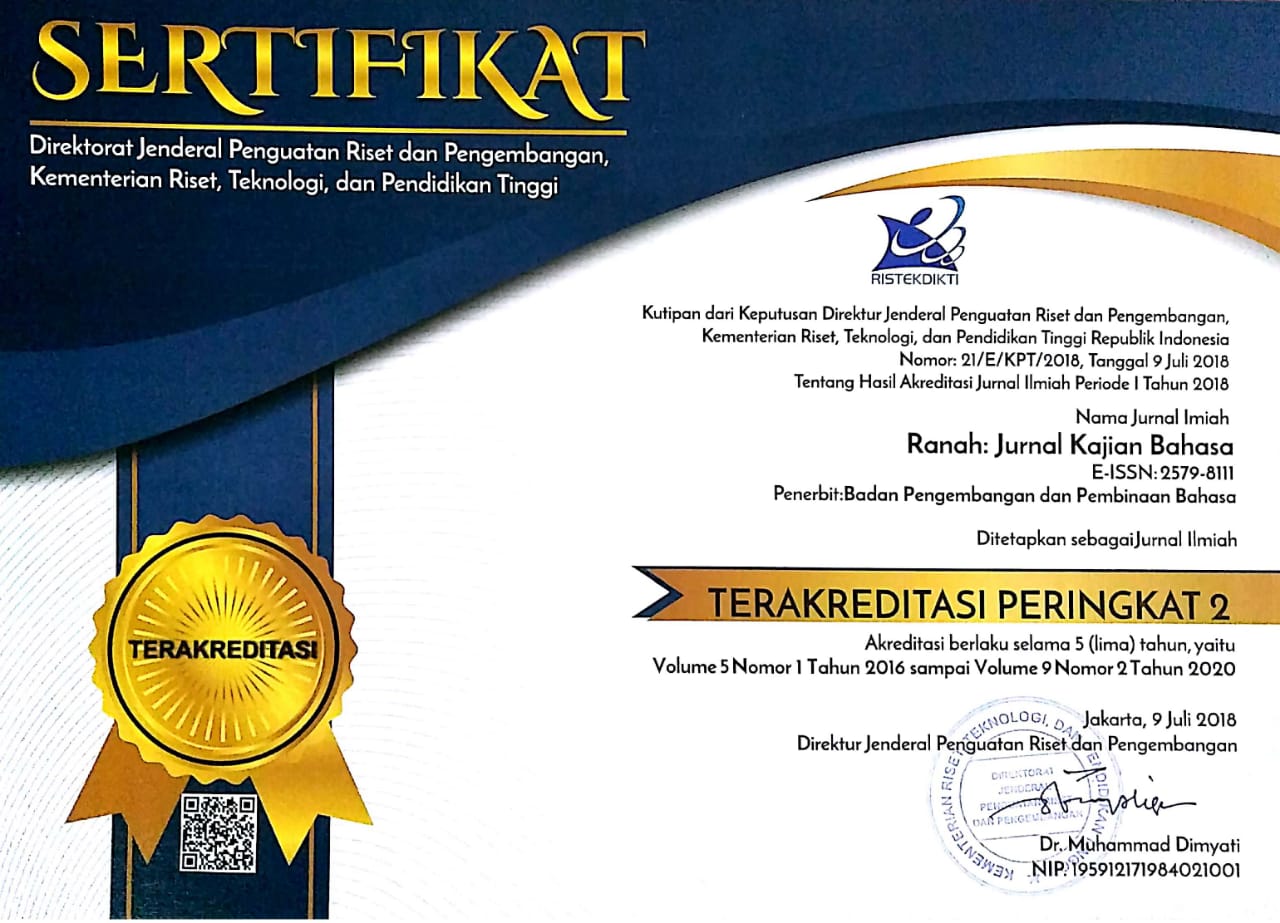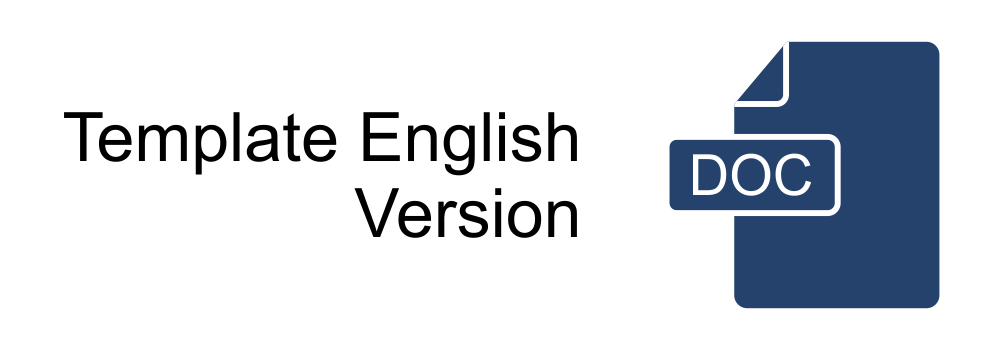Perubahan Bahasa Aceh: Tinjauan Realitas Penggunaan Bahasa Aceh dalam Interaksi Sosial di Aceh
Abstract
This study aimed to describe changes the Acehnese language in the lexical aspect in the reality of everyday Acehnese speech. Qualitative research methods have also been established as research methods for all research activities. Two groups of bilingual speakers, namely the Acehnese (Aceh-Indonesian) ethnic community who speak two languages, namely Acehnese and Indonesian in daily social interactions and the bilingual Acehnese (Aceh-Indonesian) ethnic community who use the Acehnese language in social interactions have been designated as data source. The study was carried out in three districts/cities in Aceh Province, namely Banda Aceh City, Aceh Besar District, and Aceh Jaya District, involving participants in childhood, adulthood, and old age. The results showed that the lexical changes of language were in the form of lexical loss, lexical borrowing, and lexical creation. The most dominant factor causing the Acehnese lexical change is the external motivation factor. The conclusion of this study is that the lexical change of the Acehnese language in the context of bilingual speakers has taken place, is ongoing, and has the potential to continue in line with the social changes of society due to the progress of the times.
Abstrak
Penelitian ini bertujuan mendeskripsikan perubahan bahasa Aceh pada aspek leksikal dalam realitas tuturan penutur bahasa Aceh sehari-hari. Metode penelitian kualitatif pula telah ditetapkan sebagai metode penelitian untuk keseluruhan aktivitas penelitian. Dua kelompok penutur bilingual, yaitu masyarakat etnis Aceh (Aceh-Indonesia) penutur dua bahasa, yaitu bahasa Aceh dan bahasa Indonesia dalam interaksi sosial sehari-hari dan masyarakat etnis Aceh bilingual (Aceh-Indonesia) yang menggunakan bahasa Aceh dalam interaksi sosial telah ditetapkan sebagai sumber data. Kajian dijalankan pada tiga kabupaten/kota di Provinsi Aceh, yaitu Kota Banda Aceh, Kabupaten Aceh Besar, dan Kabupaten Aceh Jaya dengan melibatkan partisipan usia kanak-kanak, usia dewasa, dan usia tua. Hasil penelitian menunjukkan bahwa perubahan leksikal bahasa wujud dalam bentuk kehilangan leksikal, peminjaman leksikal, dan penciptaan leksikal. Faktor penyebab perubahan leksikal bahasa Aceh yang paling dominan adalah faktor motivasi eksternal. Simpulan hasil kajian ini adalah perubahan leksikal bahasa Aceh dalam konteks penutur bilingual telah berlangsung, sedang berlangsung, dan memiliki potensi akan terus berlangsung sejalan dengan perubahan sosial masyarakat akibat kemajuan zaman.
Keywords
Full Text:
PDF (Bahasa Indonesia)References
Akinyode, B. F., & Khan, T. H. (2018). Step by step approach for qualitative data analysis. International Journal of Built Environment and Sustainability, 5(3), 163-174. https://doi.org/-10.11113/ijbes.v5.n3.267
Alamsyah, T., Taib, R., Idham, M., & Azwardi. (2011). Choosing Indonesian As The Children's First Language In The Family Of Acehnese Community Who Are Acehnese Native Speakers In Nanggroe Aceh Darussalam. Malay Language Journal Education, 1(2), 31-44.
Belahcen, A., & Ouahmiche, G. (2017). An investigation of language variation and change among three age-groups: a case study. International Journal of Language and Linguistics, 5(1959), 24-35. https://doi.org/10.11648/j.ijll.s.2017050301.14
Belotto, M. J. (2018). Data analysis methods for qualitative research: Managing the challenges of coding, interrater reliability, and thematic analysis. Qualitative Report, 23(11), 2622-2633. https://doi.org/10.46743/2160-3715/2018.3492
Bright, W. (2007). Social Factors in Language Change. The Handbook of Sociolinguistics, 81-91. https://doi.org/10.1002/9781405166256.ch5
Budiarsa, I. M. (2015). Language, Dialect And Register Sociolinguistic Perspective. Retorika: Jurnal Ilmu Bahasa, 1(2), 379. https://doi.org/10.22225/jr.1.2.42.379-387
Chaturvedi, S. (2015). A Sociolinguistic Study of Linguistic Variation and Code Matrix In Kanpur. Procedia - Social and Behavioral Sciences, 192, 107-115. https://doi.org/10.1016/j.sbspro-.2015.06.017
Creswell, J. W., & Poth, C. N. (2016). Qualitative inquiry & research design : choosing among five approaches. Sage Publications.
Firdaus, W. (2011). Kata-Kata Serapan Bahasa Aceh dari Bahasa Arab: Analisis Morfofonemis. Sosiohumaniora, 13(2), 223.
Firmansyah, M. A. (2021). Interferensi dan Integrasi Bahasa: Kajian Sosiolinguistik. Paramasastra, 8(1), 46-59. https://doi.org/10.26740/paramasastra.v8n1.p46-59
Heidary, B., & Barzan, P. (2019). Language Variation. November. https://doi.org/10.13140/-RG.2.2.36761.36969
Hickey, R. (2010). Language Change. In J. Verschueren, J.-O. Östman, & J. Blommaert (Eds.), Handbook of Pragmatics. John Benjamin Publishing Company. https://doi.org/-10.1075/hop.14.lan3
Hickey, R. (2014). Language Variation and Change Concepts and Definitions. https://www.uni-due.de/ELE/
Hudson, R. A. (2001). Sociolinguistics (2nd ed). Cambridge University Press.
Jones, M., & Singh, I. (2005). Exploring Language Change. Routledge.
Kabir, S. M. S. (2016). Methods of Data Collection. In In book: Basic Guidelines for Research: An Introductory Approach for All Disciplines Edition: First Chapter: 9 (pp. 201-275). Chittagong.
Koka, N. A. (2014). A sociolinguistic investigation of social stratification and linguistic variation among the kashmiri speech community. Journal of Language Teaching and Research, 5(5), 1071-1084. https://doi.org/10.4304/jltr.5.5.1071-1084
Mahdad, H. (2012). Language Change and Lexical Variation in Youth Language. Tlemcen Speech Community.
Mantiri, O. (2010). Factors Affecting Language Change. Available at SSRN 2566128. https://doi.org/10.2139/ssrn.2566128
https://doi.org/10.2139/ssrn.2566128
Mwalongo, L. J. (2017). Social factors influencing language change: A case of Kibena to Kimaswitule in Njombe district, Tanzania. European Journal of Foreign Language Teaching, 2(2), 1-18. https://doi.org/10.5281/zenodo.496189
Nordquist, R. (2019). Definition and Examples of Language Varieties These "lects" Refer to Different ways People Speak. https://www.academia.edu/
Nordquist, R. (2020). Language Change. https://www.thoughtco.com/
Poedjosoedarmo, S. (2008). Perubahan Bahasa. Disajikan dalam Seminar Ceramah Ilmiah Linguistik Pusat Kajian Melayu.
Qader, M. A., Shareah, A., Abdulhakim, B. D. M., Mudhsh, A., & Hamid, A.-T. (2015). An Overview on Dialectal Variation. International Journal of Scientific and Research Publications, 5(6), 2250-3153. www.ijsrp.org
Ramlan. (2014). Lexical Change of Pidie Dialect. State University of Medan.
Roller, M. (2017). Qualitative Research: A Collection of Articles from Research Design Review Published. Research Design Review, 3(2), 1-36.
Suprayetno, E., & Rusyfa, I. Z. A. (2020). Lexical Change in Minangkabau Language. Jurnal Mutiara Pendidikan, 4(2), 1-8.
Tahmasebi, N., Borin, L., & Jatowt, A. (2018). Survey of Computational Approaches to Lexical Semantic Change. https://doi.org/https://doi.org/10.48550/arXiv.1811.06278
Tegegne, W. (2016). The attitude of teachers towards varieties of a language and its effects on learners' education and self esteem. Journal of Literature, Languages and Linguistics, 18, 93-97.
Trudgill, P. (2012). Dialects, second edition. Dialects, Second Edition, 1-78. https://doi.org/10.4324/9780203314609
Wanjiku, N. F. (2018). Lexical variation and change in the Northern dialect of Gĩkũyũ language. Doctoral dissertation. University of Nairobi.
Wariyati, & Sutikno. (2018). Lexical Change Causes of Javanese Language in Deli Serdang Regency. Jurnal Penelitian Pendidikan Bahasa dan Sastra, 3(1), 286-296. https://doi.org/-10.32696/ojs.v3i1.88
Yule, G. (2020). The Study of Language (7th ed.). Cambridge University Press.
DOI: https://doi.org/10.26499/rnh.v11i2.5207
Refbacks
- There are currently no refbacks.








